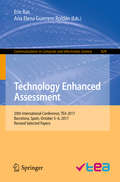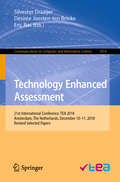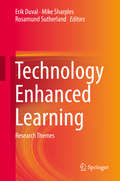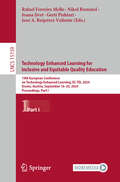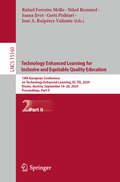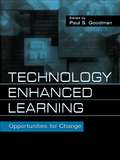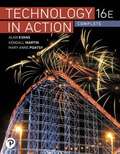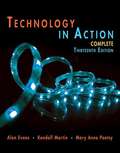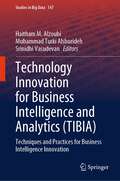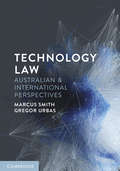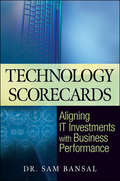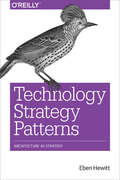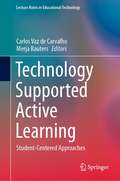- Table View
- List View
Technology Enhanced Assessment: 20th International Conference, Tea 2017, October 5-6, 2017, Barcelona, Spain (Communications In Computer And Information Science #829)
by Eric Ras Ana Elena Guerrero RoldánThis book constitutes the proceedings of the 20th International Conference on Technology Enhanced Assessment, TEA 2017, held in Barcelona, Spain, in October 2017. The 17 papers presented were carefully selected from 42 submissions. They are centered around topics like e-learning, computer-assisted instruction, interactive learning environments, collaborative learning, computing education, student assessment.Chapter "Student perception of scalable peer-feedback design in Massive Open Online Courses" is licensed under the terms of the Creative Commons Attribution 4.0 International License (http://creativecommons.org/licenses/by/4.0/). For further details see license information in the chapter.
Technology Enhanced Assessment: 21st International Conference, TEA 2018, Amsterdam, The Netherlands, December 10–11, 2018, Revised Selected Papers (Communications in Computer and Information Science #1014)
by Desirée Joosten-ten Brinke Eric Ras Silvester DraaijerThis book constitutes the proceedings of the 21st International Conference on Technology Enhanced Assessment, TEA 2018, held in Amsterdam, The Netherlands, in December 2018. The 14 papers presented were carefully selected from 34 submissions. They are centered around topics like e-learning, computer-assisted instruction, interactive learning environments, collaborative learning, computing education, student assessment.
Technology Enhanced Learning
by Erik Duval Rosamund Sutherland Mike SharplesThis book provides an overview of the state-of-the-art in Technology Enhanced Learning (TEL). It is organized as a collection of 21 clusters or research themes, each introduced by leading experts and including references to the most relevant literature on the theme of each cluster. Additionally, four seminal papers on each theme are included with expert commentaries and updates. This volume is of high value to the TEL community, a large and active group of multidisciplinary researchers, to contextualize the field and define it as a distinct research area.
Technology Enhanced Learning for Inclusive and Equitable Quality Education: 19th European Conference on Technology Enhanced Learning, EC-TEL 2024, Krems, Austria, September 16–20, 2024, Proceedings, Part I (Lecture Notes in Computer Science #15159)
by Ioana Jivet Rafael Ferreira Mello Nikol Rummel Gerti Pishtari José A. Ruipérez ValienteThe two-volume set LNCS 15159 and 15160 constitutes the proceedings of 19th European Conference on Technology Enhanced Learning, EC-TEL 2024, which took place in Krems, Austria, in September 2024. The 37 full papers, 25 poster papers, and 10 demo papers presented in the proceedings were carefully reviewed and selected from 140 submissions for research papers, and 26 poster and 19 demo submissions. They focus on effective technology adoption in educational settings, ethical concerns, and the possible digital divide these technologies could create. The theme for the 2024 conference aimed to explore the role of Technology-Enhanced Learning (TEL) in this critical context and in achieving the United Nations’ Sustainable Development Goal for education: “Ensure inclusive and equitable quality education and promote lifelong learning opportunities for all.”
Technology Enhanced Learning for Inclusive and Equitable Quality Education: 19th European Conference on Technology Enhanced Learning, EC-TEL 2024, Krems, Austria, September 16–20, 2024, Proceedings, Part II (Lecture Notes in Computer Science #15160)
by Ioana Jivet Rafael Ferreira Mello Nikol Rummel Gerti Pishtari José A. Ruipérez ValienteThe two-volume set LNCS 15159 and 15160 constitutes the proceedings of 19th European Conference on Technology Enhanced Learning, EC-TEL 2024, which took place in Krems, Austria, in September 2024. The 37 full papers, 25 poster papers, and 10 demo papers presented in the proceedings were carefully reviewed and selected from 140 submissions for research papers, and 26 poster and 19 demo submissions. They focus on effective technology adoption in educational settings, ethical concerns, and the possible digital divide these technologies could create. The theme for the 2024 conference aimed to explore the role of Technology-Enhanced Learning (TEL) in this critical context and in achieving the United Nations’ Sustainable Development Goal for education: “Ensure inclusive and equitable quality education and promote lifelong learning opportunities for all.”
Technology Enhanced Learning: Opportunities for Change
by Paul S. GoodmanThis book focuses on how technology may create new learning environments and enhance basic learning processes. The book identifies and informs some of the strategic decisions involved in designing and implementing new technology to enhance learning. It also examines specific learning applications of TEL in order to understand the context of different learning environments, as well as some of the critical lessons learned in designing these environments. Mixing both conceptual perspectives and actual case experiences should create different learning opportunities for the reader. Technology Enhanced Learning is divided into two parts. Part I deals with strategic issues, such as trends in technology, implications for educational systems, designing infrastructure, and learning environments. Part II looks at specific cases of new learning environments to learn about strategy, infrastructure, impact assessment, and change in TEL learning environments.
Technology In Action Complete
by Alan Evans Kendall Martin Mary PoatsyTechnology in Action Complete uses practical content and hands-¿on projects to engage students in computing tasks and skills they can apply at work, in class, or at home. Designed for today's technically savvy students, the text introduces difficult concepts at a basic level early on, then expands upon these skills as students build mastery. The 16th edition further emphasizes the importance of digital literacy with two new Try This projects
Technology In Action Complete, 13th Edition
by Alan Evans Kendall Martin Maryanne PoatsyFor introductory courses in computer concepts, digital literacy, or computer literacy, often including instruction in Microsoft Office. Explore, discover, and experience technology with the interactive and adaptive Technology in Action --the book that uses technology to teach technology! This book offers a learning system that pushes the envelope of what is possible in technology, and what is helpful in teaching. Although students are more comfortable with the digital environment than ever, their knowledge of the devices they use every day is still limited. The authors focus on tasks that students can accomplish with their devices, and skills they can apply immediately in the workplace, the classroom, and at home. This book fits the way students are learning today. Note: You are purchasing a standalone product; MyITLab does not come packaged with this content. Students, if interested in purchasing this title with MyITLab, ask your instructor for the correct package ISBN and Course ID. Instructors, contact your Pearson representative for more information
Technology Innovation for Business Intelligence and Analytics: Techniques and Practices for Business Intelligence Innovation (Studies in Big Data #147)
by Muhammad Turki Alshurideh Haitham M. Alzoubi Srinidhi VasudevanThis book provides a standpoint on how to effectively use technology innovation for business intelligence and analytics. It presents an approach that combines cutting-edge technological advancements with practical applications in the business world. The book covers a range of innovative technologies and how they can be applied to enhance business intelligence and analytics. It is primarily aimed at professionals in the business field data analysts and students studying subjects. This book is especially beneficial for those who want to grasp and apply the technological trends in making strategic business decisions. Its comprehensive coverage makes it an indispensable resource for anyone, in the intersection of technology and business analytics.
Technology Law: Australian and International Perspectives
by Marcus Smith Gregor UrbasThe regulation of technology is an important and topical area of law, relevant to almost all aspects of society. Technology Law: Australian and International Perspectives presents a thorough exploration of the new legal challenges created by evolving technologies, from the use of facial recognition technology in criminal investigations to the rise and regulation of cryptocurrencies. A well-written and fascinating introduction to technology law in Australia and internationally, Technology Law provides thorough coverage of the theoretical perspectives, legislation, cases and developing issues where technology and the law interact. The text covers data protection and privacy, healthcare technology, criminal justice technology, commercial transactions, cybercrime, social media and intellectual property, and canvasses the future of technology and technology law. Written by leading experts in the field, Technology Law is an excellent resource for law students and legal professionals with an interest in the area.
Technology Scorecards
by Sam BansalPlan, execute, and sustain a successful IT campaign with Sam Bansal's perfect scorecard approachFirst came the dot.com bust, then the IT squeeze. Despite software being the tail that wags the dog in most corporations, the cham-pions of IT, the CIOs, are constantly under fire to justify and maximize their IT investments--past, present, and future.Learn how to establish Key Performance Indicators and Value Scorecards for IT to ensure maximum value in your corporation with the step-by-step approach found in Sam Bansal's Technology Scorecards.Drawing on Dr. Bansal's over forty years of field experience in the management of large and complex projects, Technology Scorecards shows you how to:Create Scorecards geared towards your organization's business goalsMake quantum improvements in cost, value, and productivity using KPIs and ScorecardsIncrease your company's net by as much as 100% just by improving your supply chain management by 50%Impact your top line the most through product life-cycle managementDevelop a realistic strategy through Scorecards, which can then be used to drive IT investments that maximize your business performanceEnhance profitability. Streamline strategy execution. Lower costs. Learn how to align your IT plans with your business objectives and optimize your company's overall performance with the perfect scorecard approach found in Technology Scorecards.
Technology Strategy Patterns: Architecture as Strategy
by Eben HewittTechnologists who want their ideas heard, understood, and funded are often told to speak the language of businessâ??without really knowing what that is. This bookâ??s toolkit provides architects, product managers, technology managers, and executives with a shared languageâ??in the form of repeatable, practical patterns and templatesâ??to produce great technology strategies.Author Eben Hewitt developed 39 patterns over the course of a decade in his work as CTO, CIO, and chief architect for several global tech companies. With these proven tools, you can define, create, elaborate, refine, and communicate your architecture goals, plans, and approach in a way that executives can readily understand, approve, and execute.This book covers:Architecture and strategy: Adopt a strategic architectural mindset to make a meaningful material impactCreating your strategy: Define the components of your technology strategy using proven patternsCommunicating the strategy: Convey your technology strategy in a compelling way to a variety of audiencesBringing it all together: Employ patterns individually or in clusters for specific problems; use the complete framework for a comprehensive strategy
Technology Supported Active Learning: Student-Centered Approaches (Lecture Notes in Educational Technology)
by Carlos Vaz de Carvalho Merja BautersThis book promotes student-centered approaches to the learning process, allowing students to develop skills and competences that traditional, passive learning methods cannot foster. In turn, supporting active learning with digital technology tools creates new possibilities in terms of pedagogical design and implementation. This book addresses the latest research and practice in the use of technology to promote active learning. As such, on the one hand, it focuses on active pedagogical methodologies like problem-based learning, design thinking and agile approaches; on the other, it presents best practice cases on the use of digital environments to support these methodologies. Readers will come to understand and learn to apply active learning methodologies, either by replicating the best practices presented here, or by creating their own methods.
Technology Supported Innovations in School Education (Cognition and Exploratory Learning in the Digital Age)
by Dirk Ifenthaler Pedro Isaias Demetrios G. SampsonThis volume provides a comprehensive and contemporary depiction of the swift evolution of learning technologies and the innovations that derive from their deployment in school education. It comprises cases studies, research focused on emergent technologies and experiments with existing tools in a wide range of scenarios. The studies included in this volume explore the conceptual and practical aspects of technologies that are used to support learning, with a multidisciplinary approach that encompasses all levels of education. The three sections of this volume emphasise the use of digital technologies from the viewpoint of different fields of expertise, explore multiple educational settings where technology was implemented to support the various stages of the learning process, and underline strategies, tools and technologies that play a crucial role in the professional development of teachers.
Technology Today & Tomorrow (3rd Edition)
by James F. Fales Vincent F. Kuetemeyer Sharon BrusicTeaches you about the numerous advances being made in the different areas of technology.
Technology Today & Tomorrow (Third Edition)
by James F. Fales Vincent F. Kuetemeyer Sharon BrusicTeaches you about the numerous advances being made in the different areas of technology.
Technology Transfer Between the US, China and Taiwan: Moving Knowledge (Routledge Research on Taiwan Series)
by Douglas B. Fuller Murray A. RubinsteinExamining the flow of technical knowledge between the US, Taiwan and Mainland China over the last sixty-five years, this book shows that the technical knowledge that has moved between these states is vast and varied. It includes the invention and production of industrial goods, as well as knowledge of the patterns of corporate organization and management. Indeed, this diversity is reflected in the process itself, which is driven both by returning expatriates with knowledge acquired overseas and by successful government intervention in acquiring technology from multinational firms. Technology Transfer Between the US, China and Taiwan engages with the evolving debates on the merits, importance and feasibility of technology transfer in the process of economic development globally, and uses the example of Taiwan to show that multinational corporations can indeed play a positive role in economic development. Further, it reveals the underlying tension between international cooperation and nationalism which inevitably accompanies international exchanges, as well as the delicate balancing act required between knowledge acquisition and dangerous levels of dependency, and the beneficial role of the US in East Asia’s technological development. With contributors from disciplines ranging from history, geography, urban planning, sociology, political science and electrical engineering, this multi-disciplinary book will be of great interest to students and scholars working across a broad range of subjects including Taiwan studies, Chinese studies, economics, business studies and development studies.
Technology Transfer Systems in the United States and Germany: Lessons and Perspectives
by Proctor P. Reid H. Norman Abramson Jose Encarnacao Ulrich SchmochThis book explores major similarities and differences in the structure, conduct, and performance of the national technology transfer systems of Germany and the United States. It maps the technology transfer landscape in each country in detail, uses case studies to examine the dynamics of technology transfer in four major technology areas, and identifies areas and opportunities for further mutual learning between the two national systems.
Technology and Agribusiness: How the Technology is Impacting the Agribusiness
by Yoshifumi Nishio Amara Amara Yen-Kuang ChenThe world population is growing, and it is expected that in 2050 there will be 9.7 billion inhabitants on the Earth. According to FAO (United Nations, Food and Agriculture Organization) we need to increase the productivity of agriculture by between 50% and 70% to be able to feed the world population in 2050. Other researchers think that reducing the wastage of food may be enough to handle the 2050 population.Several factors must be considered to ensure that humanity is able to feed the world’s population in 2050 and beyond.• Less arable land: As cities are growing, the space available for agriculture is shrinking.• Climate change: Dramatic impacts on agribusiness.• Role of agribusiness on GHG emissions.• Planetary boundaries and the role of agribusiness.• Availability of freshwater.• Soil degradation.The seasonal school presents and discusses the major problems that agribusiness is facing and the different technologies that can be applied to solve and improve such issues. Specific case studies are presented along with the technological solutions that have been applied to solve or minimize the impact.Agribusiness covers different topics such as arable farming, dairy farming, fruits, vegetables, meat, etc. Each of these domains has different needs that can be addressed through smart agriculture technologies such as circuits and systems. Also, these domains affect the sustainability of the planet as they impact at least 4 out of the 9 planetary boundaries.
Technology and American Democracy
by Anthony TrottaThe growth and proliferation of technology in American society places new demands on the U.S. government and the health of its democracy, affecting both policymaking and public administration. Technology and American Democracy explores the underpinning democratic theories, including constitutional justifications, that guide decision makers during the application of Information Technology (IT) in governance to promote democratic principles such as transparency and accountability. The book examines the capacity of IT to facilitate deliberative democracy, alter modern bureaucratic structures and functions, and affect areas of public policy including public budgeting and performance measurement. Author Anthony Trotta demonstrates the ways in which technology creates new problems for contemporary government, including a discussion of virtual currency and its possible issues that must be addressed by the public sector. The discussion avoids highly technical language and confusing industry jargon, focusing instead on explaining important concepts in an accessible fashion, applicable to a broad spectrum of readers. Technology and American Democracy is required reading for students enrolled in courses on politics, public administration, and public policy.
Technology and Assessment: Proceedings from a Workshop
by National Research CouncilA report on Technology and Assessment:Thinking Ahead
Technology and Business Model Innovation: Proceedings of the International Conference on Business and Technology (ICBT2023) Volume 2 (Lecture Notes in Networks and Systems #924)
by Allam Hamdan Bahaaeddin AlareeniThis book proceedings addresses a crucial gap in understanding the impact of technology on Business Model Innovation (BMI). It emphasizes the need for further research to explore the intricate relationship between technology and BMI, focusing on opportunities and challenges. By delving into how technology influences emerging business model innovations and enhances operational efficiency, the publication aims to advance knowledge. Inviting diverse research methods, it sheds light on various ideas within the technology and BMI realm. Tailored for students, scholars, professionals, and policymakers, this book contributes to the evolving field of BMI and technology.
Technology and Business Model Innovation: Proceedings of the International Conference on Business and Technology (ICBT2023), Volume 1 (Lecture Notes in Networks and Systems #923)
by Allam Hamdan Bahaaeddin AlareeniThis book proceedings addresses a crucial gap in understanding the impact of technology on Business Model Innovation (BMI). It emphasizes the need for further research to explore the intricate relationship between technology and BMI, focusing on opportunities and challenges. By delving into how technology influences emerging business model innovations and enhances operational efficiency, the publication aims to advance knowledge. Inviting diverse research methods, it sheds light on various ideas within the technology and BMI realm. Tailored for students, scholars, professionals, and policymakers, this book contributes to the evolving field of BMI and technology.
Technology and Critical Literacy in Early Childhood
by Vivian Maria Vasquez Carol Branigan Felderman Bryan WoodsNow in its second edition, this popular text explores classrooms where technology and critical literacies are woven into childhood curricula and teaching. Using real-world stories, it addresses what ICTs afford critical literacy with young children, and how new technologies can be positioned to engage in meaningful and authentic learning. Concise but comprehensive, the text provides strategies, theoretical frameworks, demonstrations of practice, and resources for teachers. Updated with discussions of media literacy and new pedagogical tools, the second edition features new classroom examples and experiences that highlight the ways in which critical literacy, technology and media literacy come together in everyday life in the early childhood classroom. The inviting examples model how to use the interests and inquiry questions of young learners as a springboard for creating a critical curriculum. Each chapter includes Reflection Points, pedagogical invitations, and Resource Boxes to imagine new possibilities of working with students in engaging and supportive ways. The inspiring stories, guidance, and tools this book make it a great resource for pre-service teachers and students in Early Childhood Education and Literacy Education, and primary teachers and educators.
Technology and Critical Literacy in Early Childhood
by Vivian Maria Vasquez Carol Branigan FeldermanWhat do new technologies and new forms of communication mean for young children growing up in the 21st century? How are they shaping the mindsets, identities and practices which impact their lives at home and at school? This book explores the intersection of technology and critical literacy, specifically addressing what ICTs afford critical literacy work with young children between ages three to eight. Inviting readers to enter classrooms where both technology and critical literacies are woven into childhood curricula and teaching, it brings together literacy, social studies, and science in critical and integrated ways. Real-world stories show the sights and sounds of children engaged with technology in the classroom and beyond. Concise but comprehensive, the text provides strategies, theoretical frameworks, demonstrations of practice, and resources for teachers. Pedagogical features in each chapter engage readers in making connections to their own teaching situations. NCATE standards for including technology as an essential part of teacher education programs are addressed. While acknowledging how individual children employ ICT, the focus is on how new technologies can be positioned in early childhood learning communities as tools for engaging in more meaningful, authentic, and interesting learning.
